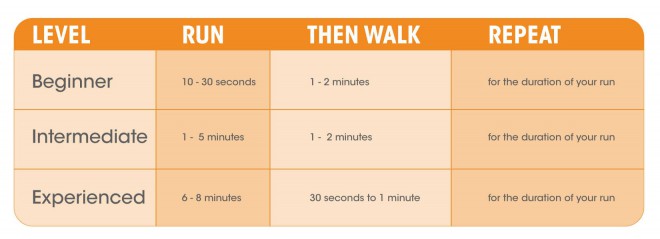Starting to run can be really daunting -- especially if you've never done it before. We're here to offer the help and support you need to get going. You can find specific steps, tips and helpful videos on how to start running -- and keep running -- right here.
How to Start Running
1. Set goals. Make achievable, short-term goals as well as a big long-term goal. Want to run a mile? 5k? Half marathon? Marathon? Or maybe your big goal is to run three times a week for a year. If your goal is weight-loss focused, you'll still need to make a running-specific goal to keep you on track. You can use our calorie-burn chart to figure out how often you should run in order to lose the weight you want.
2. Make a plan. If your goal is to run a race of some sort, you can use one of the many training plans on a site like Runners World. If your goal is to run a certain amount of times a week, schedule your running days and times, and then make them work. If you're more than 20 pounds overweight or have led a predominantly sedentary lifestyle, talk to your doctor before you start running for exercise. You're probably good to go, but you may need an "all-clear" from your doc.
3. Get the right running gear. In order to really enjoy your walking and running experience, you have to be comfortable. Getting the perfect running shoes can be difficult if you're not sure what to look for, but we can help you decide what's best for you. We can also provide tips on choosing the best running apparel.
4. Go for some long walks. Get your body moving and your heart rate up with several long, fast-paced walks before you start running. If your goal is to run 3 times a week, try walking for 20-30 minutes three times a week first. Check in with your body during and after your walks. If fast-paced walking is a challenge, keep up your walking routine until you start feeling more comfortable.
5. Then add in a little bit of running. If you've been walking for 30 minutes a day, stick to that timeline, but start adding in increments of running. Many runners -- from beginners to experts -- find the run-walk-run method (a.k.a. Galloway Method) to be a great way to approach their running workouts. Using the run-walk-run method as a beginner is especially helpful, as it gives your body a break and allows you to work running into an existing walking routine. Follow the guidelines in the table below to get the running and walking increments just right.

6. Then add one long run a week. Once you complete steps 1-4 and start to notice a big improvement in your running ability, you can continue to improve by adding one long run to your weekly routine. You can start by replacing a 30 minute run (or run-walk-run) with a 40 minute run (or run-walk run). As you start to run farther, you'll need to think about your running technique in order to avoid injuries. Take a look at the video below to make sure your running technique is good to go.
7. Keep it up! And be patient. You're in this for the long haul, but you can do it! It will take weeks (or months) for you to see results in the mirror or on the scale. But, it will likely take much less time for you to start feeling the benefits of a consistent exercise routine. Take good care of yourself and your body so you can stick to your run schedule and continue to improve.
Tips for a Healthy Running Routine
1. Take your time. Be mindful of your body and its limits. Pushing yourself to run faster, longer or harder before you're ready can lead to injuries that can keep you sidelined and throw you off track. Becoming a "runner" is more about consistency, not speed or distance.
2. Eat (and drink) right. Keep yourself hydrated and energized by eating whole foods and drinking plenty of water. You can get more details on healthy eating habits in our How to Lose Weight guide.
3. Make a schedule and stick to it. Joining a running group or finding a running buddy can help you stick to your goals. Eventually, running will become a healthy habit.

4. Warm up. A proper warm up increases your body temperature, heart rate and blood flow. Warming up before a run can greatly reduce your chances of injury. Check out our video below to get specifics about how to warm up before a run.
5. Cross-train. Once you feel comfortable with your running routine, add some strength training to your schedule. Weight lifting and yoga are two great options for your cross-training days.
6. Rest. Give your body a break before it becomes apparent that you need it. Getting a good night's sleep every night is really important, too.
Now that you're equipped with all of the info you need to start running, all that's left is to get out and there and try it. Let us know how it goes!



